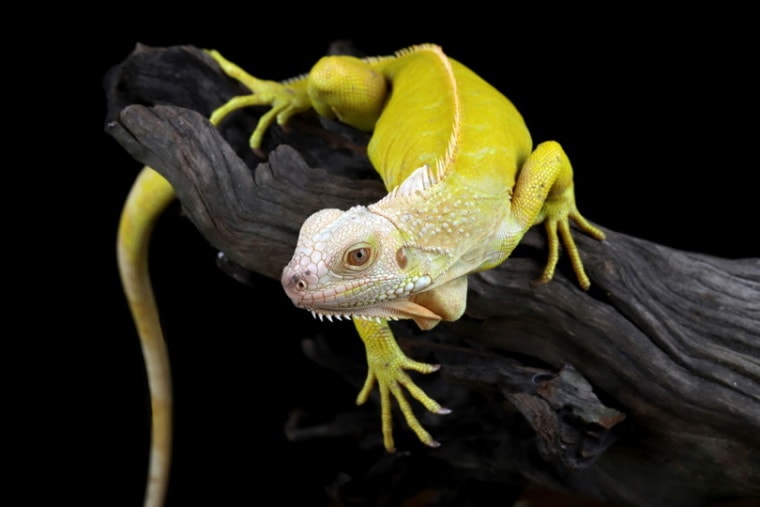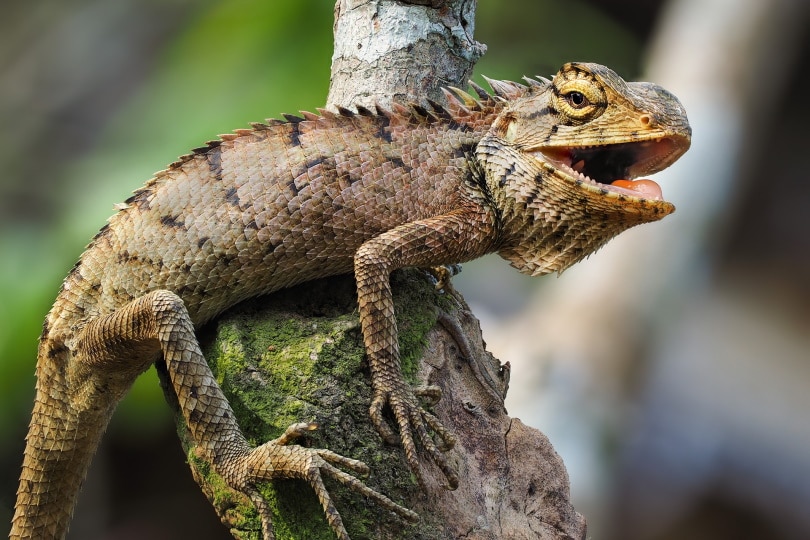
While we generally associate color-changing skin with chameleons, many reptiles change color over time. The iguanas we usually keep are green iguanas. While they’re called green iguanas, their coloring can vary from bright reddish-orange to gray-blue.
There are several reasons an iguana’s skin may change color. Iguanas change color over their lifespan and during different seasons. Here are some of the reasons an iguana’s skin might change color.
The 5 Reasons Iguanas Change Colors
1. Aging
Iguanas change color as they age. Most iguanas will start as a brighter green or blue with some brownish striping down the body and tail. The iguana’s primary coloring will become less intense as they age.
Conversely, the striping on the iguana’s tail and body will get darker and more intense as they get older. Some iguanas may start to have a reticulated pattern of color with the striping as they get older. The intensity of the striping on their body will change until they’ve reached approximately 18 months old.
In addition to their base coloring, older iguanas tend to have paler coloring on their heads than the rest of their bodies.

2. Breeding Season
Male iguanas develop an orange to reddish-orange coloring during the breeding season. In some iguanas, the color will be present over the whole body, while others may only have the orange coloring in specific areas such as the dewlap, spikes, body, or legs.
Female iguanas may also develop an orangish color during the mating season, though it is usually less saturated and intense.
Some dominant males and females will retain the orangish coloring after the mating season ends. The iguana will have the coloring in the presence of other iguanas or even cats, dogs, or humans to whom the iguana feels dominant.
3. Environment
The environment an iguana lives in also influences the appearance and color of an iguana’s skin. There are many ways that the iguana’s environment may influence its coloring. For instance, a cold iguana will take on a darker shade. The darker color of its skin helps it absorb and trap heat to keep it warm!
In addition to a darker color, an iguana that is too cold may develop dark, wavy lines on its head and body.
Conversely, an iguana kept in too hot of an environment will take on a lighter coloring. This process of color change in response to the temperature is called “physiological thermoregulation!”

4. Shedding
Iguanas’ skin also changes color a few weeks before they shed. Unlike snakes, iguanas don’t shed their entire skin at once. Iguanas shed their skin in patches, and before the skin sheds off, the skin will appear dull and take on a greyish or yellowish tone. The skin will turn white just before it falls off.
5. Disease
Iguanas can also change color because of disease. While many color changes in an iguana’s skin are natural and benign, there are some notable colorings that iguana owners should watch out for.
Other stressors may induce a color change in your iguana, including, but not limited to poor cage environment (too hot, too cold, too moist, dirty, etc.), fear of a cage mate who is a bully or of a person or other animal in the house, or significant changes in the household routine (moving, new pet or baby, etc.)
In general, any color changes not related to breeding season or shedding should be brought to the attention of your veterinarian. An experienced exotic veterinarian will be able to determine whether the color change is a problem and help you develop a plan to fix any issues that may have arisen with your iguana.

Final Thoughts
While iguanas may not change color at will like chameleons, they undergo coloring changes throughout their lifetime. It’s essential to get to know your individual iguana’s color changes, so you can immediately know if there’s a problem with your iguana’s health.
A veterinarian should examine any unusual color changes. An exotic veterinarian will be able to advise you on anything you experience with your iguana that might concern you, even if it’s just reassuring you that everything is okay.
- See Also: Fiji Banded Iguana
Featured Image Credit: Kurit afshen, Shutterstock







